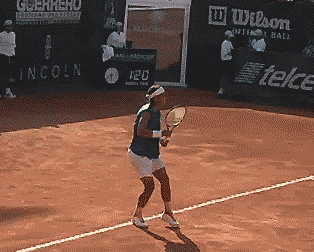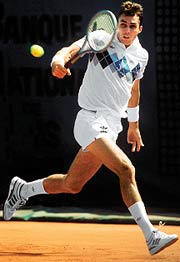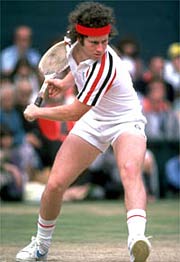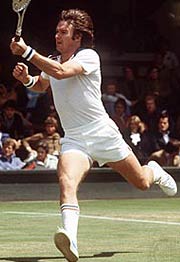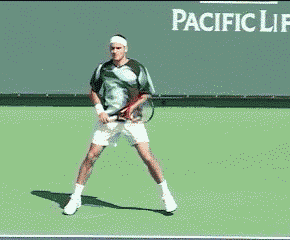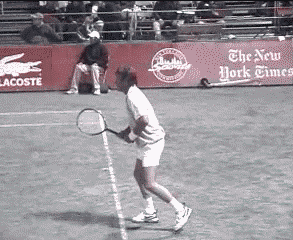|
TennisOne Lessons Dictating Play Jim McLennan
Roger Federer recorded his first clay court win over Rafael Nadal in the recent German Open. Nadal had won record 81 matches in a row on the clay, eclipsing McEnroe’s 75-match winning streak on indoor carpet back in the 80’s. They have now played eleven times, four wins for Roger and seven for Rafa. But on clay, Nadal had been to this point unbeatable, with wins at both Monte Carlo and Roland Garros in 2005 and 2006, as well as an extremely close 5 setter in Rome (with Fed holding two match points). Nadal’s depth and intensity had often driven Roger into unfamiliar territory behind the baseline, forcing the games preeminent player into a listless version of his normally dominant self. Roger has not been known to “keep the ball in play” and rally from behind the baseline (unfortunately as so many players do these days) but in the match at Hamburg, Roger finally turned the tables on Rafael, and was quoted that he, “dictated play.” It must be said, Roger did not dictate all the points, but both in his mind and in the main he did have control over the feel, the length, and the tempo of the points, and played on or inside the baseline much more often. There is more to this phrase, “dictating play” than meets the eye. And this is true at both the professional and recreational levels. More often than not, offensive players dictate against defensive players. More often the player who imposes a recurring pattern dictates. More often the dictator plays inside the court moving forward whenever the opportunity arises. And more often than not the player willing and able to “make things happen” on the big points will tend to dictate play. But, how you dictate play will always depend on the particular strengths of your own game. If your best shot is the topspin forehand crosscourt (for example) then the trick is to develop plays and strategies that work with the placement and angles available with this particular shot. Further, this may lead you back to a coach or the ball machine to actually work to develop a weapon, a strength that you can use to create repetitive offensive patterns. Further, this may lead you back to a coach or the ball machine to actually work to develop a weapon, a strength that you can use to create repetitive offensive patterns. As regards Federer and Nadal, their two clay court contests this year tell divergent stories. In Monte Carlo, the points were longer, Nadal appeared to “get on top” of Federer, and somehow Federer played behind the baseline, rarely moving forward to make things happen. Federer would prefer to shorten rallies, Rafa obviously prefers longer points. Though both men move extremely well, somehow Rafa can be most dangerous at the end of a long rally where his final “get” from extremely difficult positions results in an incredible winner. In Hamburg the match was very different. Nadal opened strong winning the first set 6-2 and played close the first three games of the second set. In the pivotal 2-1 game, Federer overcame multiple break points against his serve to hold and then ran away from Nadal. But as the match progressed, Federer was more often on or inside the baseline, and Nadal was deeper and deeper behind the baseline. Nadal mentioned that his forehand was “off,” but to my eye that had as much to do with court position as with mechanics. It is just too darn hard to thread the needle from well behind the baseline (why can’t Jimbo show this thing to Andy?).
In an earlier era Connors, McEnroe, and Lendl dictated play, but each in his own way. Connors forte was the punishing return of serve, and he placed unrelenting pressure on the server. Nothing about guile or disguise, simply Jimbo coming at you on each and every second serve. McEnroe dominated with a wicked serve and deadly first volley, and when he was on (as his three Wimbledon and three US Open titles suggest) there was no answer to his serve and volley game. Lendl, who took his lumps against Jimbo and Mac at an early stage of his career, finally turned the tables with big first serves and forehand winners on any and all poorly placed returns. In fact, McEnroe noted toward the end of his reign, that it was nearly impossible for him to place his return of serve away from Ivan’s forehand. And with each of these three champions - the pattern of play was repetitive, the opponents knew what was coming but rarely could they do much about it. Dictating play, imposing one’s game on another, telling an opponent how you will beat them, and then doing it.
Interestingly, this strategy is somewhat reversed in the Federer/Nadal rivalry because Federer’s backhand crosscourt plays into Nadal’s wicked topspin forehand. To my eye, Federer has been working on his backhand down the line, not a chip like Mac’s but a full topspin drive from as close to the baseline as possible in order to get the ball heavily into Nadal’s backhand corner. In many of his previous clay court losses Roger’s court position was poor and his backhand topspin only adequate. In the finals of this years Master’s Cup in Shanghai, as well as his victory over Francisco Gonzalez at the Australian Open, Federer showed the progress he has made on this shot, driving the backhand crosscourt toe to toe with Blake and then Gonzo and playing stunning backhand winners. Move inside the baseline when returning all second serves. Certainly this is a page from Jimbo’s book, but the golden opportunity occurs when the opponent delivers a short, weak or predictable second serve. Strategy is always about time and angle. When moving forward your angle of play increases, the opponents time to react decreases, and good things tend to happen in this scenario (to the person inside rather than beyond the baseline). Further when moving forward and playing consistently inside the baseline (whether Federer, McEnroe, Connors, or Lendl) you rob the opponent of time. Playing inside the baseline rushes and presses an opponent. And this pressure, when done repeatedly, will “crack” many an opponent.
If and when the opponent begins to double fault, even occasionally, move further inside the baseline. Pay close attention to serving patterns. For example, if the opponent double faults, then misses the very next first serve, in all likelihood this subsequent second serve will be tentative (to avoid consecutive double faults). Step forward, step in and make something happen. If the opponent misses badly with the first serve (indicating confidence issues) step forward, step in and make something happen yet again. After the match if the opponent mutters, “I have never served worse” you have indeed caused, if not dictated that outcome. Tennis is a game for a lifetime, and hopefully in your “tennis lifetime” you will experiment with varying grips, spins, and strategies. But occasionally these experiments may distract you from the single minded disposition to impose a singular stroke or strategy against an opponent, again and again and again. After all, it's fun to be the dictator. And it never hurts to pay another visit to the vision and writings of Tom Stow, coach of the only American Grand Slam champion Don Budge. He was all about hitting the ball early and solidly, about moving forward to control the points and ultimately control the opponent.
To play the "All Court Forcing Game" it is necessary to have; (1) a strong first serve and an accurate spin for the second serve… keeping the opponent from making a forcing shot is essential; (2) The groundstrokes, both forehand and backhand must be sound so that (a) the return of the serve be deep: (b) the shots from the back court be firm and well placed and (c) the coming in shot be hit flat on the top of the bounce. (3) The volley must be accurate and fast enough to put the ball away. (4) The smash is a must in this type of play for the opponent of a player with a weak overhead can lob defensively too often….Smashes, like volleys, must be put away, not only from the standpoint of winning the point but also the mental effect such shots will have on the opponent. The player of this "All Court Forcing Game" must always keep in mind the fact the he is playing another human being and that the pressure he is applying has a very definite effect on the mental attitude of his opponent. Your comments are welcome. Let us know what you think about Jim McLennan's article by emailing us here at TennisOne.
|
||||||||||||||

